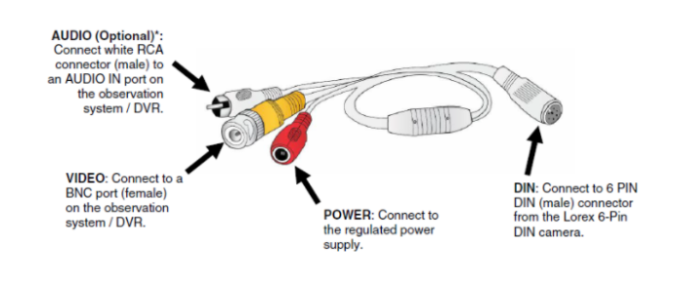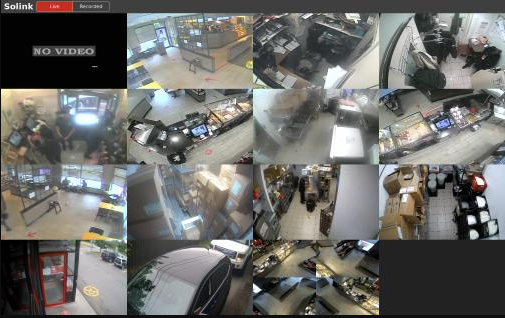Troubleshoot Offline Camera, When one of your cameras is offline, you are unable to view recorded video and may not be able to see your camera live on any of your monitors on location.
Here are some signs that you camera has gone offline:
What to do When Your Camera is Offline
The Acme support team is ready to help. Our team works with your location(s) to troubleshoot camera issues so that you can get back to recording as soon as possible. To do this, we check the following, based on your camera type:
Troubleshoot Offline Camera
.
IP Cameras: What to Look For
Acme support can identify what type of camera you have. IP cameras usually have one Ethernet cable connected to the camera.
These types of cameras optimize connection by getting power (Power over Ethernet, or POE for short) and transmitting data (sending data to the Acme system) over a single cable. A typical IP camera and Ethernet connection looks like this:
An Ethernet cable’s end looks like this:

Each camera will have an Ethernet cable that connects into a POE switch. In most environments, the switch will look similar to the following:
How to Troubleshoot an Offline IP Camera
Once you have found the POE switch, ensure that:
If everything is connected tightly and all cables have lights, you can attempt to restart the POE switch. Sometimes, a camera may become “frozen” and need a physical reboot.
Note: If you know which cable goes to the specific camera you need to troubleshoot, you can unplug and replug the cable. This is the same as rebooting the switch. Rebooting the POE switch causes all cameras to go offline for a short period of time until it powers back up fully.
If the camera still does not come back online after a physical reboot, it is possible that there is an issue on the camera end – either the cable is broken between the switch and the camera, the cable is unplugged at the camera side, or the camera itself has physical damage or defects. Acme support can assist with confirming this.
.
Analog Cameras – What to Look For
Acme support can identify if your cameras are analog. Analog cameras usually have 2-3 cables attached – one for power, one for video signal, and one (optional) for an audio signal.
The different cables look similar to the following image:

If your cameras are analog, Acme supplies an analog encoder to your location. This device converts the old analog signal into digital so that we can record it properly on our system. A standard analog encoder is displayed in the following image:
Your analog camera video cables are connected to the rear side of the encoder.
The power cables for your analog cameras are usually wired to a CCTV power supply box, or are plugged into a UPS. The image below displays an example of a CCTV power supply box:
How to Troubleshoot an Offline Analog Camera
If an analog camera is offline, you will either see NO VIDEO text on the Acme interface (and Live Monitor, if applicable), or a black screen for some models. In this case, check the following:
If all cables are tightly connected and power seems to be working for all cameras, you may require an on-site technician. It is possible that the cabling, cable ends (BNC), power supply, or the camera itself has an issue or defect. Acme support can assist.
Status of the Acme Software
Acme support can help confirm that there are no issues with the Acme interface itself that would cause a camera to stop recording. Please feel free to reach out to us at any time to confirm if there are any issues.
Troubleshoot Offline Acme System
This article provides information on the steps you can take if your recording device is offline or is not recording any video footage. If the system is offline, you cannot view recorded video and may be unable to see live video on your monitors.
This guide is available in various other languages below.
You can also watch the tutorial video below for a step-by-step guide on how to troubleshoot an offline device:
How Do I Know My System is Offline?
Some signs that your Acme system has gone offline include:
.
Troubleshooting Steps
Follow the steps in this section to troubleshoot your system. If you have completed all of the steps below and are still experiencing issues, please contact our Support team for assistance.
To troubleshoot your Acme system, you will need to check the following components:
If you have attempted to troubleshoot on your own and cannot solve the issue, contact our Support team for more assistance.
Power to the System
First, confirm your device is on and powered correctly.
Note: If your monitor is displaying live video, your device is powered correctly and you can skip this step and proceed to the next step (Connection to the Network).
There are two device types; please ensure you are aware of which of the following device types you have:
Each device has a power cable that connects to the back of the unit. Ensure it is securely connected into the recording device on one end, and that the other end is securely connected to a working power source.
Refer to the table below to verify the power outlet type for your device:
If the device is properly powered:
| Device Type | Power Outlet | Reference Image |
| Desktop Unit | DC IN | . |
| Rackmount Unit | Electrical Plug/Socket (Ensure the on/off switch is set to on.) | . |
How to Power On/Off the Recording Device
It is recommended to try powering off the device as a final troubleshooting step before contacting our support team.
Connection to the Network
In order for the recording device to be accessible on the Acme platform, it must be connected to the network.
Most units have an Ethernet cable connected to the top network port of the recording system on one end, with the other end leading to your network router or switch (depending on the environment). Here is an example:
In this case, the top cable goes to your network router. The bottom cable (as seen in the image above) normally connects directly to your cameras (i.e. a camera switch, or analog DVR). Please contact the Acme Support team to confirm that your device is connected the same way, if required.
If both cables are connected properly to the network router and camera(s), lights flash on the recording device next to your Ethernet cable. There should also be a flashing amber light labelled LAN on the front of the unit:
.
Contact Support
Please reach out to Acme support for further troubleshooting instructions if:
It is possible that Acme may need to establish a remote connection via screen-sharing application to ensure our application is running properly and that the unit does not have any physical errors or defects.











